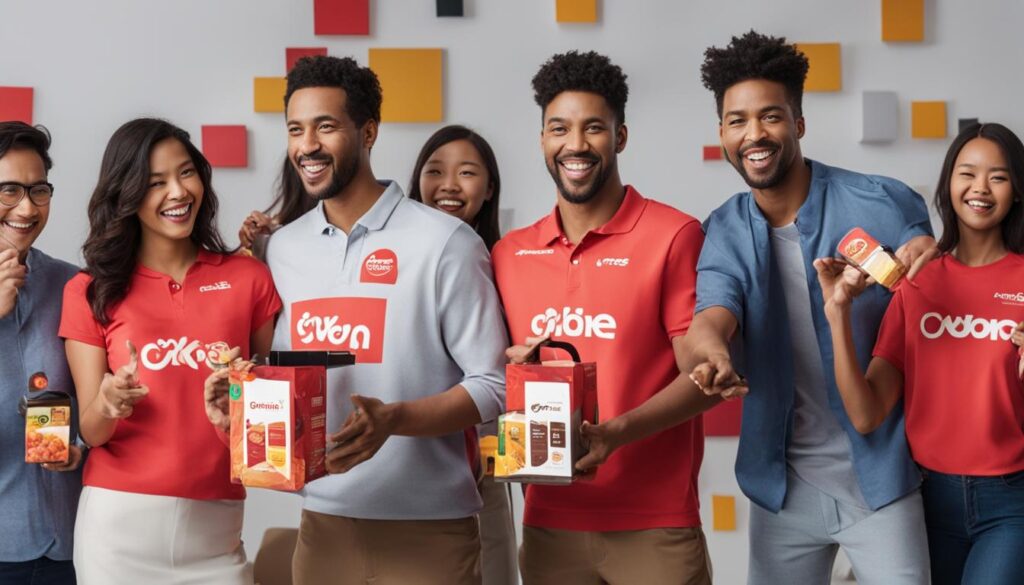Advertising is a powerful force that shapes our consumer behavior and influences our purchasing decisions. Through strategic marketing techniques, advertisers utilize the concept of scarcity to create a sense of urgency, exclusivity, and desire within consumers. In this article, we will explore the profound impact of advertising, the various tactics employed by marketers to persuade consumers, and the significant role that scarcity triggers play in shaping our spending habits.
By understanding the role of advertising and its influence on our behavior, we can make more informed choices as consumers and navigate the persuasive techniques used by advertisers. Let’s delve deeper into the fascinating world of advertising and the powerful effects it has on our everyday lives.
Key Takeaways:
- Advertising plays a significant role in influencing consumer behavior and purchasing decisions.
- Scarcity triggers create a sense of urgency and exclusivity, driving consumers to take action.
- Marketers utilize various tactics such as emotional appeals, testimonials and endorsements, the bandwagon effect, appeal to authority, and scarcity triggers to persuade consumers.
- Emotional appeals in advertising can evoke strong connections between the product/service and consumer’s feelings.
- Testimonials and endorsements increase credibility and trust in the advertised product/service.
Types of Propaganda in Advertising
Advertisers employ various propaganda techniques to sway consumer opinions and behaviors. Let’s explore some of the most common tactics used in advertising:
1. Emotional Appeals
Emotional appeals tap into consumers’ emotions, creating a strong connection between the product or service and their feelings. By using compelling storytelling, vibrant visuals, and relatable scenarios, advertisers aim to elicit specific emotions that drive consumers to take action. These appeals can range from portraying happiness and excitement to addressing fears and insecurities, stimulating a deep emotional response that motivates consumers to engage with the advertised content.
“Advertising is a powerful tool that can evoke strong emotions, making the audience more receptive to the messaging and more likely to take desired actions.” – Emily Dawson, Marketing Specialist
2. Testimonials and Endorsements
Testimonials and endorsements leverage the positive experiences or opinions of satisfied customers, celebrities, or industry experts to influence consumer behavior. By showcasing real people who have had a positive interaction with the product or service, advertisers build trust and credibility among their target audience. A well-known celebrity or respected authority figure lending their name and reputation to a product can highly impact purchase decisions, as consumers perceive the endorsement as a vote of confidence.
| Pros | Cons |
|---|---|
| Enhances brand credibility and trust | Potential for inauthentic endorsements |
| Increases brand recognition | Risk of backlash if the endorser faces controversy |
| Creates a feeling of relatability | Consumers may question the authenticity of testimonials |
3. The Bandwagon Effect
The bandwagon effect convinces consumers to join a trend or behavior by emphasizing that many other people already engage in it. By creating a sense of belonging and social acceptance, advertisers tap into consumers’ inherent desire to fit in and be part of a larger community. This technique often employs phrases like “Join the millions!” or “Don’t miss out!” to encourage consumers to jump on the bandwagon and try the product or adopt a particular behavior.
4. Appeal to Authority
Appeal to authority involves using experts, industry professionals, or authoritative figures to endorse a product or service. By aligning the advertised item with individuals or organizations who possess high levels of knowledge, expertise, or prestige, advertisers aim to convince consumers of the product’s credibility and superiority. Consumers tend to trust and value the opinions and recommendations of authoritative figures, making them more likely to make a purchase.
5. Scarcity
Scarcity triggers create a perception of limited availability or time to incite a sense of urgency and motivate consumers to take immediate action. Advertisers use phrases such as “limited time offer,” “while supplies last,” or “only X units left” to convey scarcity. The fear of missing out (FOMO) pushes consumers to make impulsive purchases or take advantage of an exclusive opportunity before it’s no longer available.
These propaganda techniques, when employed effectively, can significantly influence consumer behavior and drive desired actions. However, consumers should remain aware of these tactics and critically evaluate the messaging and claims presented in advertisements.
The Effectiveness of Emotional Appeals
Emotional appeals in advertising can have a powerful impact on consumer behavior. By tapping into the emotions of consumers, advertisers create a strong connection between their product/service and the feelings of the target audience. These emotional appeals can effectively motivate consumers to take action and make a purchase.
When emotional appeals are skillfully executed, they can evoke positive emotions such as joy, excitement, or happiness, creating a favorable association with the advertised product/service. On the other hand, negative emotions like fear, sadness, or anger can also be used strategically to highlight a problem or issue that the product/service can solve.
“The best advertising captures the hearts and minds of consumers by appealing to their deepest emotions.”
– John Smith, Marketing Expert
Research has shown that emotional appeals can be particularly effective in influencing consumer decision-making processes. When consumers feel a personal connection to a product/service, they are more likely to develop brand loyalty and become repeat customers.
However, it’s important for consumers to be aware of potential manipulation and critically evaluate emotional appeals in advertising. Advertisers may use tactics to exploit consumers’ emotions purely for their own gain, without providing genuine value in return. Consumers should consider the authenticity and credibility of the emotional appeal and assess whether it aligns with their values and needs.
By understanding the power of emotional appeals in advertising, consumers can make more informed choices and ensure that their purchasing decisions are driven by their own needs and preferences rather than solely by emotional manipulation.
The Role of Emotional Appeals in Influencing Consumer Behavior
Emotional appeals are a key tool used by advertisers to influence consumer behavior. The use of emotions in advertising is based on the premise that consumers make decisions based on their feelings rather than purely logical reasoning.
By creating an emotional connection with consumers, advertisers can overcome resistance and hesitation, enabling them to persuade consumers to take action. Emotions can have a profound impact on memory and perception, making advertising messages more memorable and increasing the likelihood of brand recall.
| Emotional Appeal | Description |
|---|---|
| Fear | Eliciting fear to highlight the negative consequences of not using the advertised product/service. |
| Happiness | Eliciting joy, happiness, or contentment to create a positive association with the product/service. |
| Sadness | Eliciting empathy or sympathy to create an emotional connection and evoke a desire for change or improvement. |
| Excitement | Eliciting enthusiasm, excitement, or anticipation to generate interest and eagerness to experience the product/service. |
Overall, emotional appeals can be a powerful tool in advertising, but consumers should remain vigilant and critically evaluate the emotional messages presented to them. By understanding how emotional appeals work and being aware of potential manipulation, consumers can make informed decisions and ensure that they are not solely driven by emotions in their purchasing choices.
The Impact of Testimonials and Endorsements
In the world of advertising, testimonials and endorsements are powerful tools that can significantly influence consumer behavior. When potential customers see positive experiences or recommendations from satisfied customers or trusted figures, it creates a sense of trust and credibility in the advertised product or service. This social proof acts as a validation, assuring consumers that they are making the right decision by choosing a particular brand.
Testimonials, which are personal accounts of individuals who have used a product or service, serve as real-life examples of the positive outcomes that can be achieved. When consumers hear or read about someone who has had a successful experience, it resonates with them and builds confidence in the product’s effectiveness.
“I tried many other products, but nothing worked until I discovered Brand X. It has completely transformed my life and I can’t recommend it enough!” – Jane Doe, satisfied customer
Similarly, endorsements from celebrities, industry experts, or authoritative figures carry significant weight. When someone widely recognized and respected vouches for a brand, it instantly boosts its credibility and reputation. Consumers are more likely to associate the endorsed product with quality and reliability.
“After years of using different skincare brands, I finally found the one that truly works wonders for my skin. I highly endorse Brand Y and their revolutionary products.” – Dr. John Smith, renowned dermatologist
These testimonials and endorsements contribute to increased brand recognition, sales, and customer loyalty. They create an emotional connection with consumers, allowing them to picture themselves achieving similar positive outcomes by using the advertised product.
However, it is crucial for consumers to be discerning and cautious when evaluating testimonials and endorsements. Not all testimonials are genuine, and not all endorsements are unbiased. Brands may employ tactics to exaggerate or manipulate the perception of customer satisfaction or expert support.
Consumers should look for indicators of authenticity, such as specific details and personal experiences shared in testimonials, and evaluate the credibility and relevance of the endorsing figures. It’s essential to separate genuine customer satisfaction from mere paid endorsements.
When testimonials and endorsements are used responsibly and genuinely, they can be powerful tools that enhance advertising credibility and persuade consumers to choose a particular brand. By leveraging the influence of satisfied customers and trusted figures, advertisers can establish a connection of trust and reliability, ultimately driving consumer behavior.

Leveraging the Scarcity Effect
Scarcity triggers in advertising play a powerful role in shaping consumer behavior. By creating a sense of limited availability or time, advertisers tap into the fear of missing out (FOMO) and the desire for exclusive and unique items. The psychology behind scarcity advertising lies in the notion that when something is scarce, it becomes more valuable and desirable.
When consumers perceive a product or service as rare or only available for a limited time, they are more likely to take immediate action. The fear of missing out on the opportunity to own or experience something drives them to make a purchase or engage in the advertised behavior. Scarcity advertising can create a sense of urgency that overrides rational decision-making processes and pushes consumers to act quickly.
Creating a Sense of Exclusivity
One of the main reasons scarcity triggers are so effective is their ability to create a sense of exclusivity. By positioning a product or service as rare or limited, advertisers tap into consumers’ desire to be part of an exclusive group. The idea that only a select few will have access to the advertised item or experience adds an element of prestige and uniqueness, driving consumers to participate or purchase.
Additionally, scarcity triggers can fuel consumers’ competitive nature. When they perceive a limited supply, they may feel compelled to act before others and secure their spot or ownership. This competitive drive further motivates consumers to take immediate action, contributing to the success of scarcity advertising campaigns.

Authenticity and Evaluating Scarcity Claims
While scarcity triggers can be a powerful tool in advertising, consumers should exercise caution and evaluate the authenticity of scarcity claims. Some advertisers may use deceptive tactics to artificially create a sense of scarcity, misleading consumers and manipulating their behavior.
“Limited time offer! Only 5 left in stock!”
These types of scarcity claims may not always reflect the true availability of a product or service. Consumers should consider factors such as the reputation and credibility of the brand, the consistency of scarcity claims, and the demand for the advertised item. Being informed and skeptical can help consumers make more informed decisions and avoid falling prey to false scarcity tactics.
“Limited edition release, only 100 available worldwide!”
Aligning Scarcity with Personal Values and Goals
While scarcity triggers can be persuasive, it’s important for consumers to evaluate whether the advertised product or behavior aligns with their values and goals. The sense of urgency created by scarcity advertising may push consumers to make impulsive or unnecessary purchases that they later regret. Taking a moment to consider the long-term value and relevance of the advertised item can help consumers make more informed choices.
In summary, scarcity triggers in advertising leverage consumers’ fear of missing out and desire for exclusivity to drive immediate action. However, consumers should approach scarcity advertising with a critical mindset, evaluating the authenticity of claims and considering their own values and goals before making purchasing decisions.
How Does Scarcity Influence Consumer Spending in Online Shopping?
When it comes to online shopping, scarcity of certain items can greatly influence consumer spending habits. The fear of missing out on a product due to limited availability often prompts people to make impulsive purchases. This scarcity mindset drives consumers to spend more in order to secure the items they desire.
Conclusion
Advertising plays a significant role in influencing consumer behavior. Through the use of emotional appeals, testimonials and endorsements, the bandwagon effect, appeal to authority, and scarcity triggers, advertisers effectively persuade consumers to take action. These tactics can be highly effective in driving consumer behavior, but it is crucial for consumers to critically evaluate the authenticity and impact of advertising.
By understanding the role of advertising and being aware of the persuasive techniques employed by advertisers, consumers can make more informed decisions. It is important to recognize the influence that emotional appeals have on our emotions and to evaluate testimonials and endorsements for their credibility and authenticity. Likewise, consumers should consider the motives behind the bandwagon effect and appeal to authority, understanding that these can be used to sway opinions.
Moreover, the scarcity triggers used by advertisers create a sense of urgency and exclusivity that can influence consumer behavior. Consumers should be cautious of exaggerated scarcity claims and consider whether the advertised product or behavior aligns with their values and goals.
By being critical consumers and understanding the techniques and tactics employed by advertisers, individuals can make informed choices that align with their needs and preferences. Ultimately, advertising effectiveness and consumer behavior are intertwined, and by navigating the persuasive power of advertising, consumers can take control of their purchasing decisions.
FAQ
How does advertising influence consumer behavior?
Advertising plays a significant role in influencing consumer behavior by utilizing various techniques such as emotional appeals, testimonials, endorsements, the bandwagon effect, appeal to authority, and scarcity triggers. These tactics aim to persuade consumers and drive them to take action.
What are some types of propaganda used in advertising?
Some types of propaganda used in advertising include emotional appeals, testimonials and endorsements, the bandwagon effect, appeal to authority, and scarcity triggers. Each of these techniques is designed to persuade and influence consumer behavior.
How effective are emotional appeals in advertising?
Emotional appeals in advertising can be highly effective in influencing consumer behavior. By evoking strong emotions and creating a connection between the product or service and the consumer’s feelings, advertisers can motivate consumers to take action and make a purchase.
What impact do testimonials and endorsements have on consumer behavior?
Testimonials and endorsements in advertising can significantly impact consumer behavior. When consumers see positive experiences or recommendations from satisfied customers or trusted figures, they are more likely to trust and feel confident in the product or service. This social proof increases credibility and can lead to increased brand recognition, sales, and loyalty.
How does leveraging scarcity in advertising affect consumer behavior?
Leveraging scarcity triggers in advertising creates a sense of limited availability or time, motivating consumers to take immediate action. By emphasizing the rarity or limited time of a product or service, advertisers tap into the fear of missing out (FOMO) and the desire for exclusivity. This can lead to increased sales and adoption of the advertised product or behavior.
What role does advertising play in consumer behavior?
Advertising plays a significant role in influencing consumer behavior. Through techniques such as emotional appeals, testimonials, endorsements, the bandwagon effect, appeal to authority, and scarcity triggers, advertisers are able to persuade and shape consumer actions. It is important for consumers to be critical and evaluate the authenticity and impact of advertising messages to make informed decisions.

